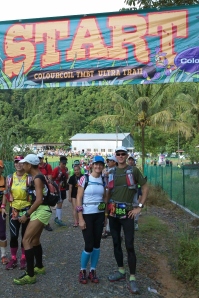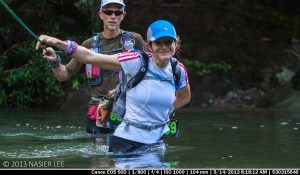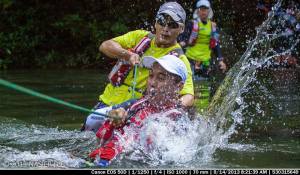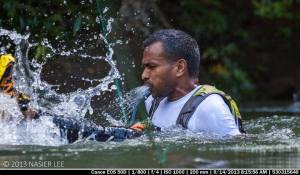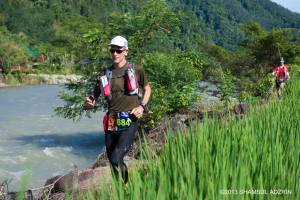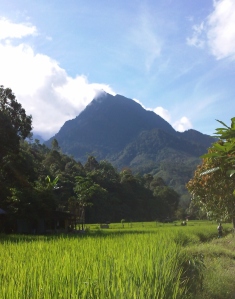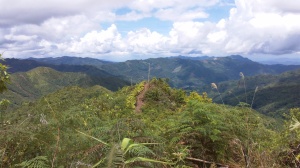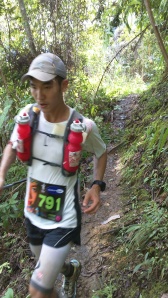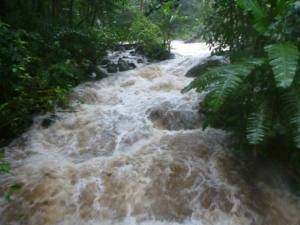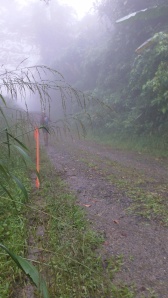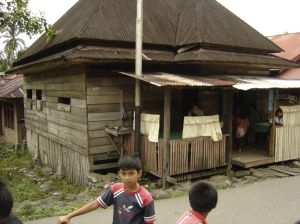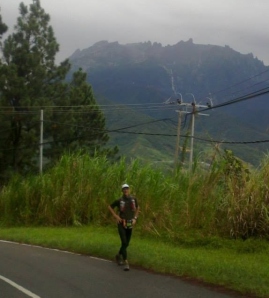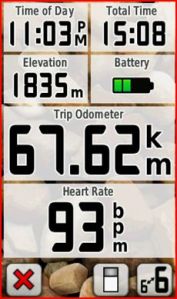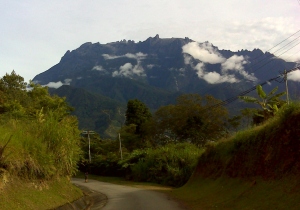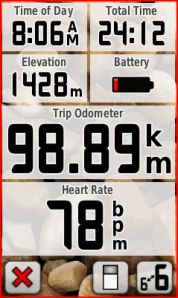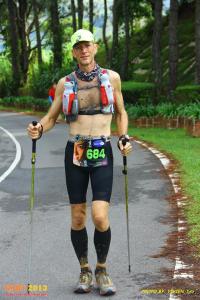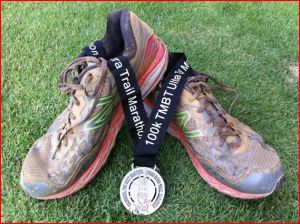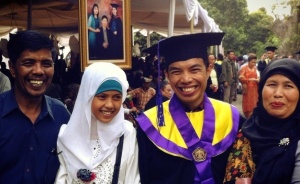Bus horns pierced the dawn in the heart of Kota Kinabalu at 5:00 am sharp, signaling the movement of a caravan of busses and vans transporting the 800+ TMBT participants to the starting point two hours away. To get from the road to the starting point, all the participants had to pass over a long swinging suspension bridge. We were limited to five people at a time on the bridge, so it took quite a while just to get everyone checked-in for the race!
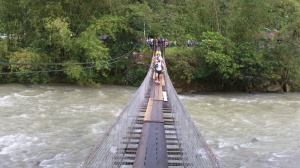
Crossing the suspension bridge from the bus drop off to the Start area. Only 5 people allowed on the bridge at a time.
As expected, the 7:00 am flag off was delayed until just after 8:00 am, once the last runner finally got across the bridge and checked in. It was shaping up to be excellent weather for running, a nice partly cloudy day. Debbie Chinn, my training partner from Penang, and I steadily made our way to the front of the starting line to be ahead of the pack. Jiri Vjistein from Czech Republic, podium finisher in the first 2 TMBTs, and Jimmy Tee, last year’s winner, along with a band of other gnarly young professional looking runners were already there. Any pipe dreams of a podium finish are quickly dispelled.
From the course description, we know we will face two to three suspension bridges and a river crossing all before the first 4.4 km water station. Our strategy is to head out fast to make it to the first bridge at the front of the pack.
When the gun goes off, there is the usual surge of runners pushing forward. Obviously, the guy with his walking sticks out blocking my way did not heed the race director’s plea to line up according to one’s projected pace and finish time. The course started out on an old tar road with some immediate small hills. Debbie and I had passed up the majority of runners by the time we arrived at the first suspension bridge at the 1.5 km mark. We only have a couple minutes delay in crossing as we wait for those before us to cross, five at a time. I can only imagine how long it took for the last runner to get across this bridge. The course was marked with dangling lengths of 1” red plastic construction ribbon tied to branches, fence posts, and what-have-you. However, when arriving at a junction in the path, the direction of the course was often not immediately clear. Sometimes we benefitted from others’ mistakes; sometimes we found ourselves on the wrong trail. Soon, we reached the first river crossing. We plunged in and made our way across.
Strategically located event photographers snapped some great shots. Our crossing was smooth and uneventful . . . unlike that of some others!
The lead pack was well ahead of us, but between km 5 and km 10, a small group of runners were within sight of each other. I glanced down at my Garmin to see my heart rate was alarmingly around 153, well above my target aerobic heart rate of 138. The wisdom of more experienced ultra runners rang in my ears, “start slow and go slower.” Adrenalin surging, I had been caught up in the excitement of the race. I just couldn’t slow down and lose the lead I had already built up . . . So I pushed on, trying to hang with Debbie and others. (On training runs, Debbie and I were near dead even in speed and endurance levels.) Between 10-15 km, I started feeling the ghastly twinge of potential cramps coming on in my calves. I felt hot. My heart rate was still high. I quickly reassessed. Barely past 1/10th of the race distance and my legs were telling me this was not going to be the day for any records. With potential cramping coming on so early and already feeling overheated, I began to doubt if my body would cooperate for the full 100 km run. The first 25 km on the elevation chart had looked to be the easiest section of the whole run. Looks were definitely deceiving! I caught up to Debbie to let her know I was slowing down. I told her to run her own race. I was fine; I just needed to slow down (or so I hoped!).
I began to feel better, but I was still baffled. I’d run many training runs more challenging than this, but today I was feeling exhausted and depleted. Soon, we hit the hills leading up to the pineapple ridge. I was able to keep going as long as I went slower. I stopped at the top of the hill to grab some nutrition and fluid from the back of my pack. A couple of runners passed me, but few were in sight behind me. The day was turning out to be picture perfect and the scenery was indeed spectacular. I grabbed my video camera and snapped some shots.
By the 19 km point, we had started on a loop which would take us up to Miki Camp jungle trail where we would cross a couple of small streams. Not even to the 20 km point yet and this race was already a bear! The loop had a kilometer section of two-way traffic, which I only became aware of when a few of the lead runners barreled toward me on a narrow ledge. I hugged the hill and let them pass in stride.
On the Miki Camp trail I ran out of water and twice filled my water bottle in the stream, popping in an iodine tablet for purification. I could not afford to get dehydrated at this early stage. Finally, I completed the loop and hit the two-way traffic section. I made it to water station 3 at the 25 km point. On the sign in sheet, I was number 21. Debbie was 14th. I sat in a chair and began filling my water bottles and hydration bladder. Three young and seemingly fit international runners were pulling out of the race – DNF at 25 km – foot injury, stomach problems, etc. I didn’t feel great, but I was nowhere near throwing in the towel. With three DNFs, I was now 18th. I headed out for the next leg as dark clouds began to roll in. I made it down a set of rough concrete steps, just before the rain hit, and just before the steps became mossy and slippery from the rain. I would later find out that the rain was heavy across the ridge at Miki Camp and that the knee-deep streams I easily crossed had become impassable, raging torrents.
When I hit a T-junction with the blacktop road there were no markers in sight in either direction, but up to the right I saw 3 runners heading toward me. They had gone the wrong direction and were now backtracking. Thankful for their timely return, I started down to the left, and after a short while, began to see markers. The rain had now reached me and it felt good. It was cooling me down. The next few km were up hill walking, on paved and gravel roads. The path was too steep to run, but my training had prepared me well for walking up hill. It was a good place to be during the rain. As the elevation increased, I seemed to walk right into the clouds. The rain had slowed to a steady drizzle. It was becoming increasingly difficult to spot the markers.
I caught up to another runner and we chatted for a while. He was a local guy from Sabah who was keeping a pretty good pace. He was one of the three runners I had seen coming toward me. He thought he was in 7th place in the 50 km category, but before his three km detour, he had been in 4th place. After a while we noticed, we had not seen markers for a while so we backtracked, and sure enough, the trail had headed off from a hairpin turn onto a grassy jungle slope. We trudged single file, shoes sloshing through mud, while the rain continued to pelt us.
We hit the main highway where we had a three km stretch of uphill walking on the shoulder of the road. Monotony along this section led me to think about the students RIEI has assisted with scholarships: Nugroho, Ruddi, and Syaweli were the first 3 boys to study in America. Three schools in America had bought into RIEI’s vision and mission and had provided RIEI with full tuition scholarships for our chosen students. Mila, Tikka, and Hesty followed in successive years at Darlington School. Septi, orphaned by an earthquake in Sumatra, is now in her final year of midwifery school in Indonesia. Each of these students had overcome hard life circumstances to succeed and excel in school. Nugroho, with a degree in accounting, now has a job with an oil company in Indonesia. Ruddi, who graduated as an art major, is now on the creative design team of a private TV station and working on the set of the “Indonesian Dr. Oz Show.” Last month, I attended Syaweli’s graduation from the prestigious University of Indonesia with a degree in Public Health. This year, Hesty is starting in the Business & Management School of the University of Indonesia after earning one of a scant 35 spots available after the nationwide exam. Over 4,500 students applied, all hoping to attend this Business & Management School. Hesty’s achievement is impressive. The economic poverty of Hesty’s family qualified her for the highest possible government subsidy for her university education, but she would still have to come up with the $150 semester fee plus books, room & board. Enter RIEI, making Hesty’s dream of a university degree possible.
As I continued trudging uphill through the rain on the side of a highway in Borneo some 40 km into my day, I asked myself was this really that HARD? Does choosing to sign up for an ultra-trail marathon . . . training on the beautiful trails of Penang . . . decking out in full ultra gear . . . purchasing loads of Hammer nutrition . . . running in the beauty of nature really qualify as a HARD thing? How can this compare to losing one’s family in landslides triggered by a massive earthquake? How does it stack up against the bleak possibilities for a university education when your mother cooks all day to sell meals on the front porch for fifty cents each to make ends meet and your father can hardly find a job as a day laborer? How does this 100 km trail run compare to the HARD lives of some of our students? I was reminded of Syaweli’s every present warm smile and upbeat attitude. Though his house was a simple board house with no running water, he was immensely proud of his home.
Life has not been easy for these RIEI scholarship students, but often it is those who have had to overcome adversity, that develop a sense of understanding and appreciation for the opportunities they do have. RIEI provided Syaweli with the stepping-stones necessary to achieve his highest academic potential. RIEI students broaden their views and understanding of the world and learn to make friendships across religious and ethnic lines as they attend school in the US and interact with American and international students.
At this point in the run, I started thinking this 100 km ultra-trail marathon is a CHALLENGING thing more than a HARD thing. I signed up for the CHALLENGE, I trained for the CHALLENGE and here I am almost half way through my CHALLENGE. The HARD path trudged by our RIEI students did not end at a 100 KM checkpoint. I’m starting to feel better, a bit revived.
I follow the trail through some farm areas, then a gravel road leading up to the main road, which I recognize from my previous trip to Mt. Kinabalu. The rain is easing up and the fog is lifting as I approach the home stretch to the 50 km drop bag point. As I’m heading up the final hill, a lady asks to snap my photo with Mt. Kinabalu behind me, and of course, I oblige. When she asks how to send it to me, I give her my race number, which she immediately recognizes as she turns out to be our friend, Ellen Goh, who had just talked to Cindy by phone a few minutes prior to meeting me on the trail.
I sign in at 5:26 pm, quickly find my drop bag, and head into the men’s changing tent. I’m the only one there. I down two small cans of tomato juice (high in potassium), some beef jerky, and other nutrition packs. I change into dry clothes and instantly feel better. I fish out my walking poles, which I wished I’d had for the past 25 km. I hear Debbie outside and find that she is just departing from the 50 km checkpoint, but I am nowhere near ready to leave. I need rest and food. In all, I spend just over an hour at the checkpoint. When I head out, I’m wearing my headlight and carrying an orange, some crackers and beef jerky for a progressive supper. As I start down the trail, I’m still in 21st place.
Walking along the grassy farm road, eating my supper as I go, I step into a rut hidden beneath the grass and slightly twist my left ankle. Yikes! It is not too bad, but I had better be more careful. After a few km, I meet a small tar road. A Japanese runner catches up to me, and together, we search for the correct direction. Finally, I get out my course instructions and learn that we are to turn left and go down the hill. We cross the main highway and then head up the slopes of Kinabalu on a hard surface road that soon deteriorates into a muddy, rocky roadbed, but it keeps heading up at a good slope. Walking is the only option. Soon a young British guy joins us. The three of us stay together most of the way, but I fall back toward the end before arriving at water station 8. From there, we will head out for one final 10 km trail loop through a cabbage farm, and then will arrive back at this same water station point. I feel good, so I don’t stop long, although they have chairs and hot coffee available. Just as I am about to head out on the loop, Justin, my seatmate from the bus arrives. His feet are killing him as his Salomons were not the right sole for rocky terrain and he is forced to DNF at this point. (The airline lost his luggage, which had his drop bag and his second pair of shoes in it.)
The lead female runner was back and about ready to head down. She was complaining about how poorly marked the trail was through the cabbage patch. She got lost several times, waiting 20 minutes at one point for a rescue after calling the race organizer hotline. In preparation, I pulled my phone out of my pack and carried it in a more accessible place. I texted my wife at this point, 10:15 pm, 64 km down, 36 km to go. A British runner caught up to me as I was texting and we walked together for a good distance. The cabbage farm trail was one laborious journey through deep, sticky mud, and foot high road ruts with large rocks randomly scattered throughout the roadbed. Any thought of keeping our shoes dry was quickly deemed impossible. We just had to embrace the mud and carry on. However, perhaps because we were going slower and had been forewarned, as long as we kept looking up toward the path in front of us, we were able to spot reflective markers clearly marking the way. I never got lost on this section. At 11:03 pm, I reached the highest elevation point on the course. My internal batteries were starting to wind down just as those in my Garmin were showing half power.
As I slowed down to dig out some nutrition from my pack, my British companion continued on at his brisk pace. I did not try to keep up. “Run your own race” was my mantra, I just want to finish strong, and I found when I tried to keep up to someone else’s pace, it took too much out of me, though it was nice to chat with fellow participants along the way.
Back to water station 8 on the loop, now water station 9, I refilled my water bottles and hydration bladder. I sat down for a few minutes and had a cup of coffee. I still felt reasonably good, so I soon headed down the long mountain road to the final water station at the base of the hill – 13 km away. It was 1:15 am and I was now in 25th place. Thankfully, the night was clear with a few stars peeking out from behind the clouds, despite the near full moon. If it had rained during this night section, it would have made things VERY miserable. The first part of this section was two-way traffic, with the last of the runners making their way up the hill. It was energizing to be passing them, as I was able to run down part of the asphalt road where it was not too steep.
Again, I found myself alone for the bulk of this downhill slog. Overall, I’m guessing I ran 70% of the race solo. As the hours wore on, I felt myself bonking. I felt overheated, so I stopped and took off my shirt and hat. I took in more gel, electrolytes, nuts, anything I could find in my pack. I leaned on my trekking poles going downhill as my legs got more and more tired of the constant downward slog. The poles helped provide stability so I was able to avoid slipping on muddy sections. A runner scurried past me and was soon out of sight. I recall looking at my Garmin at one point and it read 80 km. Only 20 to go! A LONG while later, I looked at it again – 80.8 km. Only 19.2 to go . . . how much further to the bottom of this relentless hill?!!! Two more runners passed me.
I finally made it down to water station 10 at 5:00 am. I was hoping to take my pack off and lay on the floor for a while, but there was only a tarp tent beside the road with a little table. The attendants offered me a chair, which I gladly took while refueling and refilling water supplies. I enjoyed joking with the ladies in Malay. After finding out how long it took to get down that last section, they asked if I had stopped to sleep somewhere. My response was, “Tidur sambil jalan” (sleeping while walking). We could see for miles back up the dark hill and there was not a headlight in sight. Just 12 km more to get to the finish line.
I crossed the main highway and was able to run a bit down the isolated road, which soon turned into a gravel roadbed as it begin its assent toward the Finish Point. Midway up, dawn crept across the dark sky at 6:20 am. The climb was constant and steady, but not terribly steep, and at this point, my legs felt better going uphill than downhill. Finally, I crested the hill, and just across a valley, I could see the hotel marking the finish point. It looked quite close, but my Garmin told me I still had 5 km to go. “The road must wind around the hill at a gentle incline,” I thought. Finally, the worst is over! But no, the race director had a “nastier route” in mind. Rather than skirting around the hill, he decided to make us go over top of the hill. More steep and rugged climbs, but amazingly, I was feeling pretty good at this point and I was enjoying the crisp mountain air. As I rounded a corner just about a kilometer from the finish line, Mt. Kinabalu loomed directly in front of me – taking my breath away!
Yes, this truly was The Most Beautiful Thing. Mount Kinabalu was especially radiant at 8:00 am, 99 km into running my first ultra-trail marathon. I rounded the turn and made my way up the last 300-meter stretch to the finish line. Suddenly, I was engulfed by the sound of loud applause and cheers from onlookers as well as those who had finished the race before me. I had not expected that, but indeed it felt celebratory to be completing my first ever ultra event on the course of what can rightfully be billed as Asia’s toughest ultra-trail course. I finished right at 24 hours; by my estimation, the 31st finisher out of 330 who started the day on the 100 km course.
This was indeed a HARD thing, but the word CHALLENGING now seems to describe it better. I completed my 100 km CHALLENGE and now I CHALLENGE you to make this truly THE MOST BEAUTIFUL THING by donating $1/trail km I completed to help further the education of deserving, but impoverished students. Together, we can pave the way for these students to a future empowered by education. Take the CHALLENGE. I am glad I did.
Donations can be sent to:
RIEI
P.O. Box 1036
Rome, GA 30162
U.S.A.
Please make checks payable to RIEI (Ruble International Education Initiative). RIEI is a registered 501(c)3 Non-Profit Organization. EIN #26-1525304 [RIEI has no paid staff, 100% of funds go directly to scholarship expenses.]
Or you can make a contribution via PayPal:
![]()

